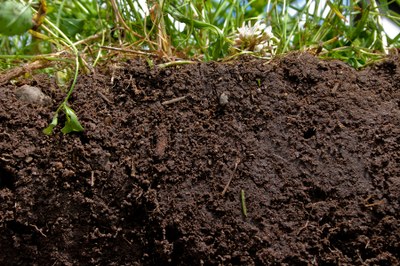Grow your own gold
 Do you want to improve the soil in your garden? Add organic matter. Organic matter is so valuable it is sometimes called “black gold” by gardeners.
Do you want to improve the soil in your garden? Add organic matter. Organic matter is so valuable it is sometimes called “black gold” by gardeners.
The addition of organic matter will improve nearly every soil. In clay soils, organic matter breaks open the ground, allowing for better drainage and aeration. In sandy soils, organic matter helps soil to hold onto nutrients and water. Organic matter adds nutrients too.
You can add organic matter to your soil by sowing a cover crop now. These crops will blanket the soil and protect it from eroding over winter. Cover crops will capture nutrients deep in the soil and bring the nutrients near the surface for next year’s crop. Cover crops can collect snow, improve drainage and reduce weeds in the future.
Cover crops can be sown in any area of the garden that is finished producing vegetables. You can also sow between the rows of crops that are still producing.
At this time of year there are two strategies for growing cover crops:
Oats (Avena sativa) should be sown now. The oats will put on good growth this fall and die over winter. It will be easily tilled into the soil in spring or mowed and left as a mulch. This is a good option for land where you plan on growing early spring crops such as carrot, spinach and pea. Annual ryegrass (Lolium multiflorum) is an alternative to oats.
Winter rye (Secale cereale) can be planted anytime in September (the sooner, the better). Winter rye will grow vigorously this fall and begin growing again in spring. This is a good strategy for land that will be planted late in spring with warm-season crops (tomato, cucumber and squash). Mow and then cultivate the rye into the soil in early May. No-till gardeners can spray it with glyphosate in spring to kill it. Give it a couple weeks to break down and then plant your crops at the end of the month. Winter wheat (Triticum aestivum) is an alternative to winter rye.
Seeds are available from catalogs and farm supply stores. Sow oats at 4 oz., winter rye and winter wheat at 3 oz., and annual ryegrass at 2 oz. per 100 square feet.
Written by Tom Kalb, Extension Horticulturist, North Dakota State University. The photo was made available under a Creative Commons license specified by the photographer: Natural Resources Conservation Service. This article was originally published in the NDSU Yard & Garden Report. Sources used for this article: Cornell University. 2013. Improve your soil with cover crops. Ithaca, NY; and Johnny's Selected Seeds. 2015. Cover crops comparison. Albion, ME.





